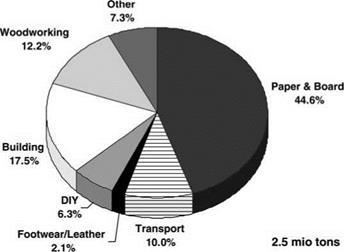Today, in adhesive bonding technology there is still much empiricism. Whereas, in the design, calculation, creation and quality assurance of welded joints there exist fully developed standard sets of rules, guidelines and specifications that have been
|
Figure 9.1 The Western European adhesives market, 2007. The key market segments are indicated; values shown are in tons. (Illustration courtesy of Industrieverband Klebstoffe e. V.). |
accepted and approved, this is not the case for bonded joints. Neither are there any well-defined criteria for the selection of adhesives and the determination of specific process parameters. For example, although the surface preparation of substrates is virtually always demanded, it is definitely not always needed.
With few exceptions, the trend in adhesives development will not be towards further increases in bonding strength, as this is not necessary in most cases. Although long-term durability often seems to have room for improvement, it is aspects of easy processability, high safety of the resultant product, ecological aspects and physiological compatibility that will rather shape further developments.
These requirements can be easily met if the chemical reactions involved when creating an adhesive bonded joint take place, as far as possible, at the adhesive’s manufacturing stage. To this end, adhesives should be delivered with as high a molecular weight as possible, the potential candidates for this approach being hot melts and dispersion adhesives. Pressure-sensitive adhesives will also play an important role, being perfectly suited to semi-structural or even structural bonding applications. For example, bus body panels can be fixed very effectively to frames, stiffening profiles into truck cabs, and sectioned headlinings into car roofs, in a single operational sequence using PSAs with very high long-term durability. Nonetheless, the mechanical characteristics of these materials still need to be improved.
One interesting aspect in the development of adhesive bonding technology is that of ‘bonding on demand’ adhesives; these already exist in the medical sector, and everybody has heard of Post-it® notes in the office. Stretch-release tapes are also available; these can be removed from a joint by pulling a tab and stretching it in parallel to the bonding area. Yet further developments are currently under investigation and will surely open up new markets.
Engineers often underestimate the structural performance of adhesives, and use them only for nonstructural applications, tending to select products with a strength — oriented approach. Two clearly provocative questions illustrate this way of thinking.
How do you define the strength that is actually required from an adhesive in the lap joint doublers of commercial aircraft such that it can prevent the formation of uncontrolled cracks — which it clearly does? Also, how do you define the strength required from a car body adhesive so that it can drastically increase the fatigue strength of a spot-welded adhesive-bonded joint — as it often does?
It is clear that adhesive bonding technology offers far more than today’s applications, and has enormous future potential, despite it rarely being possible to implement adhesive-bonded joints straight from the drawing board on the basis of sets of rules and specifications. In the future, manufacturing technology will undoubtedly change to allow the performance and risk assessment of adhesive bonded joints to be more accurate and reliable. When compared to former times, today’s products are designed and optimized under completely different rules, with the main focus being on vital questions such as shortages of raw materials, total energy content and the environment-friendly disposal or reuse ofa product. Although we must accept these facts, we must at the same time try to change our habits without impairing our quality of life. A car body does not necessarily require many hundreds of welding spots in order to be solid and durable — at the end of the car’s life each welding spot will need to be crushed and shredded. Likewise, bonded windscreens and rear windows that cannot be removed cause major problems in recycling. Both of these items could just as easily be bonded on demand — a subject which must be worthy of great consideration.
 25 января, 2016
25 января, 2016  Pokraskin
Pokraskin 
 Опубликовано в рубрике
Опубликовано в рубрике 